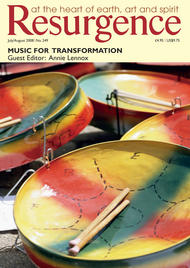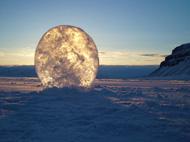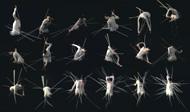BEFORE ME IS a wall of glacial ice forty-five metres high, slowly, inextricably moving towards Noorderlicht as we navigate the seas just thirty metres from it, at six o’clock in the morning. Another cold grey day is dawning as I project video from the boat, a series of texts onto the glacier face. At times the image is swallowed up, disappearing through aeons of ice and then as we traverse the glacier it is reflected magically back with an electronic edge that gives the texts a living urgency. ‘Sadness Melts’, ‘The Cold Library of Ice’, ‘Burning Ice’: texts that bring into focus the state we are in, as the glacier continues its accelerated path towards total melt and oblivion.
There have been five Cape Farewell expeditions into the Arctic, on which forty-five artists/creators and fifteen scientists have co-habited, sailed, observed, measured and been inspired. The outcome of this collective effort becomes ever more poignant. In this high Arctic of sea, land and ice are three climatic tipping points of such significance that their demise or alteration promises a global effect on our environment:
• The top end of the Gulf Stream or Norwegian Current. Both Cape Farewell’s and other scientific studies indicate that the current’s health appears robust; however, its temperature has increased. At the parallel 78° north the current travels north twenty metres below the surface and is the size of two Amazon rivers.
• The Greenland Ice Cap. The ice cap is undoubtedly melting with increased tempo. To give scale to this melt, on the Greenland mainland, which has a land mass the size of Europe, the ice is over 3,000 metres thick.
• Ice melt at the North Pole. Most worryingly, in the summer of 2007, 25% of the northern ice cap melted and it is predicted that all the summer ice at the North Pole could disappear within a decade. The consequences of this happening would be a rapidly warming sea due to more absorption of the sun’s power, a change that will accelerate the warming of our planet.
Our onboard scientists, from the National Oceanography Centre and the British Geological Survey, measure, analyse and collect data, which adds to a global scientific effort to establish clarity on climate change and the timescale of that change. Importantly, the Cape Farewell artists can witness and absorb the physicality of the science fieldwork – slow, careful and at times laborious. It is up to the artists to bring back stories and emotions on a human scale of these tangible climatic changes that we ignore at our peril. Our warming planet is affecting the natural Arctic balance, a warming that is caused by how we, as a species, choose to live. Some of our most exciting cultural thinkers and practitioners have added their weight to the Cape Farewell project. The changing climate is largely a cultural problem and we need vision to move us out of the dangerous situation that we are in.
THIS NORTHERN MAGIC, this harsh physical place, these climate impacts have become marked into my very being – the Arctic has become part of my emotional force, powerful and addictive. For me, artistically, this emotional force is best expressed in and by the mercurial nature of ice.
Ice is not an object, and it is difficult to view objectively. If you move it, it changes: thousands of hair-line cracks fracture its purity. If you raise its temperature, it ceases to be. If you analyse it, unlike rock it releases its information, its history in an instant; there are no repeats and no reviews. Ice is alive. The wall of ice we engaged with is in the process of dying – 100,000 years of knowledge going, going, gone. It is a non-biological changing force and I can only engage with it subjectively as I would another living form. It has a language that is as clear as words, and understanding it is like dealing with poetry and raw emotion.
Ice is the million-year-old history of our planet. From it we know what the air, temperature and world were like at any given point, just by analysing ice-core samples. Our actions are burning this cold library of ice.
There is no one kind of ice: we have sampled new sea ice, decade-old sea ice, glacier ice, diamond-clear ice, black ice, ice clouds that cause vertical light refractions. There are glaciers that move with speed, whole landscapes on the move, rocks and valleys sculpted by their force, and we have witnessed and nearly been entrapped as the sea froze solid before our eyes. The ice that sits upon waves, causing a sea to perambulate as in a frightening dream: sea and glacial ice that we have had to force a passage through aboard our boat, but which leaves no memory of our passing as it reforms neatly in our wake.
Ice is fascinating to project video onto, and as well as the previously mentioned texts, I have projected a walking, naked and pregnant woman, running feet and a newborn baby. The texts projected onto ice are slogans that appeal for an immediate emotional engagement with climate. The running feet carry urgency whilst the pregnant woman is layered in meaning. I am often surprised just how powerful this image has become and how well it resonates. She epitomises vulnerability and promotes care. She is naked, without the armour and the protection of clothes. Her walk is defiant and in her belly she carries the only possible future for humankind. Her growing baby has a lifespan in front of her/him, yet the image is projected on ice that is disappearing: two future truths colliding in opposing time-planes. If we have it inside us to care for, nurture and protect our children then surely we must also nurture and protect their environment. No other symbol better encapsulates the need for a symbiotic relationship between humans and our habitat.
A Californian artist who has also journeyed with Cape Farewell is Amy Balkin. In the process of making a series of artworks called ‘Public Smog’ she has stated, “We should make our atmosphere into a world heritage site.” We know inherently that to dump waste on a designated world heritage site is wrong. We wouldn’t pollute such a site; but having the same sense of wrong with regard to our atmosphere should be even more of a priority.
Ian McEwan lends his word-craft and wisdom to our BBC film with powerful insights. He also made a ‘word sculpture’, lines of text that were projected onto the outside walls of the Bodleian in Oxford – words physically impressing themselves upon a custodian of our heritage: “The pressure of our numbers, the abundance of our inventions, the blind forces of our desires and needs are generating heat – the hot breath of our civilisation… We are shaped by our history and biology to frame our plans within the short term, within the scale of a single lifetime. Now we are asked to address the well-being of unborn individuals we will never meet and who, contrary to the usual terms of human interaction, will not be returning the favour.”
The sculptor Antony Gormley collaborated with the architect Peter Clegg to produce a triptych of snow constructions on the edge of a frozen Arctic sea. In temperatures of -35°C they toiled for four days to produce Three Made Places. One Made Place came from an idea Clegg had been working on to demonstrate physically the invisible, odourless greenhouse gas CO2. Clegg has written, “One kilogram of CO2 at atmospheric pressure occupies 0.54 of a cubic metre. That is the volume taken up by ourselves and the space immediately around us – it is roughly the volume occupied by a coffin.” In Canada each member of the population produces 23,000kg of CO2 per annum. In the UK it’s 12,000kg per person.
Gormley made another artwork where he cast himself in ice, Marker 1. It stood on the frozen sea of the fjord until spring and ice melt arrived and the sea reclaimed it.
EACH ARTIST WHO has been part of the Cape Farewell expeditions has found a voice that deals in some way with climate change. Each has added uniquely to a new bank of ideas and imagery that brings the subject of climate change into focus on a human scale. The process of the artists developing their Arctic work is recorded by the director David Hinton in a film we were commissioned to make for the BBC. This film, Art from a Changing Arctic, has been shown worldwide and is part of the Cape Farewell exhibition ‘The Ship: The Art of Climate Change’, which was first mounted at London’s Natural History Museum: sixteen works of art that include a whole-whale-skeleton artwork by Heather Ackroyd and Dan Harvey; a cinema-scale video projection of the demise of an iceberg, The End of Ice; and a work by the choreographer Siobhan Davies entitled Endangered Species in which a virtual dancer dances to extinction in an antique display cabinet. This exhibition is now on a world tour which this year includes Madrid and Tokyo, bringing new and provocative voices and ideas to the issue of climate change.
Science continues to lead our enquiries into climate change. One of the great pleasures for me during the past ten years has been the open dialogue we have with the worldwide climate science community. These are the most rational people I know, and to detect in them a real concern and at times palpable fear that they have for humanity and of irreversible damage being done to our planet is very worrying. They are clear that the window of opportunity for action is short: perhaps just a decade.
Echoing Balkin, the solution is simple: stop polluting our atmosphere with damaging greenhouse gases. But we have a global economy and a lifestyle based on the cheap supply of energy that will require a Herculean effort to reverse. There is, however, the possibility of a cultural shift, as was witnessed in the Age of Enlightenment: a wind of change that embraces all and in doing so secures our, and our children’s future.
Maybe this is the evolving story of Cape Farewell: to rattle the cage and throw some of our best creative minds into the mêlée. To paraphrase McEwan in our film, we’re having to address the needs of people unborn. Even the most idealistic of thinkers on the world stage in the past have only addressed themselves to problems in the present. To bear the weight of the future in this way is both interesting and difficult and runs (probably) counter to our nature.
The Cape Farewell project continues with two expeditions to Greenland in September 2008. A youth expedition carrying 26 students from 8 different countries will be followed by an art/science team furthering the oceanography conducted in the Greenland Sea last autumn. Working alongside the scientists will be an international team of musicians, playwrights, visual artists, architects and academics. It will be possible to track both voyages live on the website and both will be filmed for a forthcoming sequel to Art from a Changing Arctic. www.capefarewell.com
David Buckland is a video artist and Director of the Cape Farewell project. Burning Ice: Art and Climate Change, published by Cape Farewell, is available at £19.99. Tel: +44 (0) 1904 431213 to order a copy.










